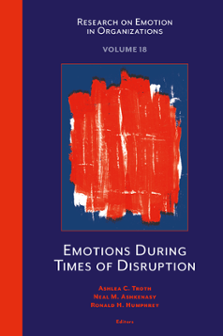
Index
Emotions During Times of Disruption
ISBN: 978-1-80382-838-1, eISBN: 978-1-80382-837-4
ISSN: 1746-9791
Publication date: 20 January 2023
Citation
(2023), "Index", Troth, A.C., Ashkanasy, N.M. and Humphrey, R.H. (Ed.) Emotions During Times of Disruption (Research on Emotion in Organizations, Vol. 18), Emerald Publishing Limited, Leeds, pp. 297-303. https://doi.org/10.1108/S1746-979120220000018016
Publisher
:Emerald Publishing Limited
Copyright © 2023 by Emerald Publishing Limited
INDEX
- Prelims
- Emotions and Disruption
- Part I Emotions in Disruptive Contexts
- Emotional Socialization in Times of Disruption: A Mixed-Methods Case Study of Emotional Labor Among Nonprofit Employees During Covid-19
- Ambivalent Feeling About Organizational Change Under NPM
- Releasing the Pressure Valve: Workplace Relationships and Engagement in a Context of Disruption
- Emotional Labor in Interaction with Patients, Companions, and Coworkers: A Multilevel Approach in a Hospital Context
- Part II Emotions and Performance-Related Outcomes During Disruption
- Workplace Interruptions and Emotional Regulation
- Pulled in Two Directions: How Affect Activation Predicts Resource Allocation Among Multiple Goals
- Team Decision-Making in Crisis: How Affect Asymmetry and Team Process Norms Affect Decision-Making
- Effect of Emotional Intelligence and Strategic Management of Technology on Organizational Performance
- Part III The Role of Supervisors and Leaders in Disruption
- Supervisory Gaslighting and Its Effects on Employee Affective Commitment
- How Leaders Regulate Emotions Experienced During Organization Change Events
- Leading Through Dreaded Emotions: A Review on the Adaptive Roles and Functions of Fear, Anger, and Sadness in Leadership
- Part IV Conclusions
- Learnings and Solutions About Emotions During Disruption
- Index